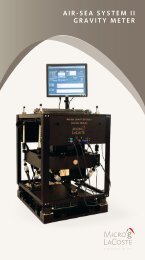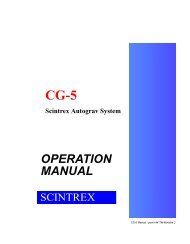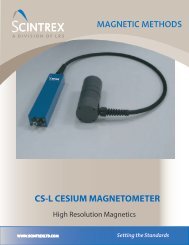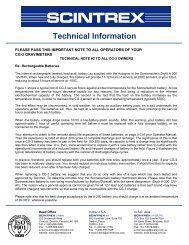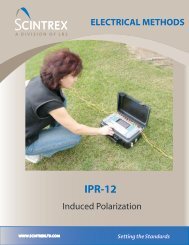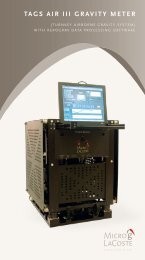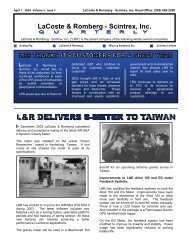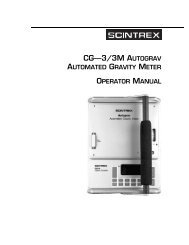CS-L Cesium Vapor Magnetometer Sensor OPERATION ... - Scintrex
CS-L Cesium Vapor Magnetometer Sensor OPERATION ... - Scintrex
CS-L Cesium Vapor Magnetometer Sensor OPERATION ... - Scintrex
You also want an ePaper? Increase the reach of your titles
YUMPU automatically turns print PDFs into web optimized ePapers that Google loves.
Reference<br />
The narrow bandwidth resonant light causes momentary alignment<br />
(polarization) of the atomic magnetic moments to the direction of the<br />
ambient magnetic field. The resonant light "optically pumps" the cesium<br />
atoms to a higher energy state. (Note that the polarizing light beam has to be<br />
oriented in the general direction of the ambient field to be effective.)<br />
Large numbers of cesium atoms can be polarized by optical pumping and then<br />
induced to precess coherently in phase around the ambient field by means of a small<br />
magnetic field, H1. This small magnetic field is transverse to the ambient field and<br />
alternating at the Larmor frequency.<br />
The H1 field is produced by a coil in the <strong>CS</strong>-L. The coil is coaxial with the sensor<br />
optical axis and wound around the absorption cell. Polarized resonant light<br />
perpendicular to the ambient magnetic field detects the precession. This light is<br />
alternately more or less absorbed, depending on the instantaneous orientation of the<br />
polarization.<br />
In the <strong>CS</strong>-L, this probing light is the perpendicular component of the resonant light<br />
beam. If the modulation of through-the-absorption-cell transmitted light is detected<br />
with the photosensitive detector, and the resulting Larmor signal is sufficiently<br />
amplified and phase-shifted before being fed back to the H1 coil, then a closed loop<br />
self-oscillating circuit results.<br />
The resonance occurs at the Larmor frequency, which in weak fields, e.g. the Earth's<br />
magnetic field, is precisely linear with the field in which the absorption cell is<br />
located. For the cesium 133 the proportionality constant (gyromagnetic constant) is<br />
3.498577 Hz per nT.<br />
As indicated, different components of the same resonant light beam perform two<br />
functions:<br />
• the component parallel to the ambient field performs the optical pumping<br />
• the perpendicular component detects the coherent precession.<br />
Therefore, no pumping is taking place if the light beam (the optical axis) is<br />
perpendicular to the ambient field (the equatorial orientation) and<br />
consequently the sensor is not operating. Equally, no light modulation is taking place<br />
if the light beam is parallel with the ambient field (the polar orientation) and<br />
consequently the sensor is not operating.<br />
The second reason for the sensor not operating in the polar orientation is that the H1<br />
field, being parallel to the ambient field, can not induce precession of the magnetic<br />
polarization.<br />
The plane perpendicular to the ambient field divides the sensor operating<br />
zones into two hemispheres - northern and southern operating hemisphere. In<br />
the northern operating hemisphere the sensor light beam, which propagates in<br />
the direction of the optical axis forms an angle from 0° to 90°<br />
with the direction of the ambient field. In this hemisphere, the phase shift of<br />
the Larmor signal amplifier required for the self-oscillation at the peak of the<br />
resonance is -90°.<br />
7—4<br />
P/N 763701 Rev. 1



